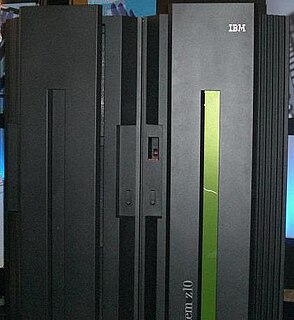IBM mainframes are large computer systems produced by IBM since 1952. During the 1960s and 1970s, IBM dominated the large computer market. Current mainframe computers in IBM's line of business computers are developments of the basic design of the IBM System/360.

Multiple Virtual Storage, more commonly called MVS, was the most commonly used operating system on the System/370 and System/390 IBM mainframe computers. IBM developed MVS, along with OS/VS1 and SVS, as a successor to OS/360. It is unrelated to IBM's other mainframe operating system lines, e.g., VSE, VM, TPF.

VSEn is an operating system for IBM mainframe computers, the latest one in the DOS/360 lineage, which originated in 1965.

z/OS is a 64-bit operating system for IBM z/Architecture mainframes, introduced by IBM in October 2000. It derives from and is the successor to OS/390, which in turn followed a string of MVS versions. Like OS/390, z/OS combines a number of formerly separate, related products, some of which are still optional. z/OS has the attributes of modern operating systems, but also retains much of the older functionality originated in the 1960s and still in regular use—z/OS is designed for backward compatibility.

OS/390 is an IBM operating system for the System/390 IBM mainframe computers.

Hercules is a computer emulator allowing software written for IBM mainframe computers and for plug compatible mainframes to run on other types of computer hardware, notably on low-cost personal computers. Development started in 1999 by Roger Bowler, a mainframe systems programmer.

VM is a family of IBM virtual machine operating systems used on IBM mainframes System/370, System/390, zSeries, System z and compatible systems, including the Hercules emulator for personal computers.

Amdahl Corporation was an information technology company which specialized in IBM mainframe-compatible computer products, some of which were regarded as supercomputers competing with those from Cray Research. Founded in 1970 by Gene Amdahl, a former IBM computer engineer best known as chief architect of System/360, it was a wholly owned subsidiary of Fujitsu since 1997. The company was located in Sunnyvale, California.
z/Architecture, initially and briefly called ESA Modal Extensions (ESAME), is IBM's 64-bit complex instruction set computer (CISC) instruction set architecture, implemented by its mainframe computers. IBM introduced its first z/Architecture-based system, the z900, in late 2000. Later z/Architecture systems include the IBM z800, z990, z890, System z9, System z10, zEnterprise 196, zEnterprise 114, zEC12, zBC12, z13, z14, z15 and z16.
In computing, a Parallel Sysplex is a cluster of IBM mainframes acting together as a single system image with z/OS. Used for disaster recovery, Parallel Sysplex combines data sharing and parallel computing to allow a cluster of up to 32 systems to share a workload for high performance and high availability.
A logical partition (LPAR) is a subset of a computer's hardware resources, virtualized as a separate computer. In effect, a physical machine can be partitioned into multiple logical partitions, each hosting a separate instance of an operating system.

IBM System z9 is a line of IBM mainframe computers. The first models were available on September 16, 2005. The System z9 also marks the end of the previously used eServer zSeries naming convention. It was also the last mainframe computer that NASA ever used.
Since the rise of the personal computer in the 1980s, IBM and other vendors have created PC-based IBM-compatible mainframes which are compatible with the larger IBM mainframe computers. For a period of time PC-based mainframe-compatible systems had a lower price and did not require as much electricity or floor space. However, they sacrificed performance and were not as dependable as mainframe-class hardware. These products have been popular with mainframe developers, in education and training settings, for very small companies with non-critical processing, and in certain disaster relief roles.

IBM Z is a family name used by IBM for all of its z/Architecture mainframe computers.
UTS is a discontinued implementation of the UNIX operating system for IBM mainframe computers. Amdahl created the first versions of UTS, and released it in May 1981, with UTS Global acquiring rights to the product in 2002. UTS Global has since gone out of business.
The history of IBM mainframe operating systems is significant within the history of mainframe operating systems, because of IBM's long-standing position as the world's largest hardware supplier of mainframe computers. IBM mainframes run operating systems supplied by IBM and by third parties.

IBM System z10 is a line of IBM mainframes. The z10 Enterprise Class (EC) was announced on February 26, 2008. On October 21, 2008, IBM announced the z10 Business Class (BC), a scaled-down version of the z10 EC. The System z10 represents the first model family powered by the z10 quad core processing engine. Its successors are the zEnterprise System models introduced in 2010 and 2012.
Linux on IBM Z or Linux on zSystems is the collective term for the Linux operating system compiled to run on IBM mainframes, especially IBM Z / IBM zSystems and IBM LinuxONE servers. Similar terms which imply the same meaning are Linux/390, Linux/390x, etc. The three Linux distributions certified for usage on the IBM Z hardware platform are Red Hat Enterprise Linux, SUSE Linux Enterprise Server, and Ubuntu.

The IBM System/390 is the discontinued fifth generation of the System/360 instruction set architecture. The first ESA/390 computer was the Enterprise System/9000 (ES/9000) family, which were introduced in 1990. These were followed by the 9672 CMOS System/390 mainframe family in the mid-1990s. These systems followed the IBM 3090, with over a decade of follow-ons. The ESA/390 was succeeded by the 64-bit z/Architecture in 2000.










